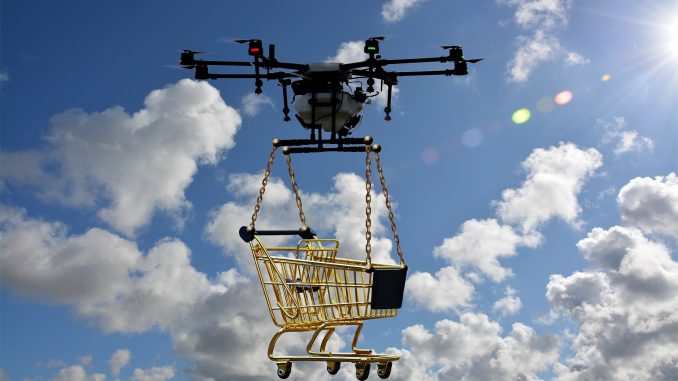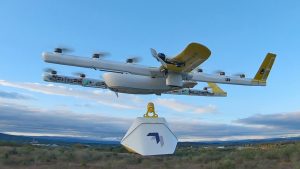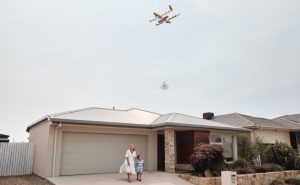
“Is that an invasion or maneuver of robot birds?” said Xinyi Ji, who has first seen delivery drones in Canberra last year.
In suburbs of Canberra and Queensland, there is an odd scene often happening in recent years. People stand on streets and look up at the sky without regard to blinding sunshine or bad weather. Some of them exude expectation and others seem to be confused. Following with their sight, several unusual drones break the tranquil sky that fly crisscross with packages. A science fiction world? In fact, this is drone delivery.
The Rise of an Emerging Delivery
As COVID-19 restricted people’s access to outside and direct contacts with others, delivery industry has strived to ease people’s inconvenience of travel in a safe mode. Although the first application of drone delivery happened in America in 2016, it has not started to be extensively applied until 2019. Australia, Canada and so on also gradually implement drone delivery.
In Australia, there are two main corporations taking charge of drone delivery, Wing and Swoop. Compared with Swoop focusing on transporting medical resources, Wing owned by Alphabet is more frequently used by/influences normal people that serves their daily supplies.
However, whether drone delivery can be full-scale operated or replace the traditional method still has controversies in society, economy and the environment, such as RAND organization’s public policy investigation demonstrates drones’ energy usage is same with trucks. This kind of concern threatens profits of stakeholders, like consumers, suppliers and communities.

How About the Properties of Drone Delivery?
“They look advanced and regulated with unified packaging,” Xinyi said.
The delivery drones which Australian residents currently see almost belong to Wing, because it is the primary execution in Australia. Wing’s drones are 4.3 ft in length and 3.3 ft in width and have a speed of 104.4 km/h. The capacity is 1.2 kg and flies in a range of 20 km.
“It is quite larger than I imagined that has no differences with birds before approaching,” Xinyi said.
Besides, people only need to utilize Wing’s app to order commodities and the steps are exactly similar to manual delivery. When drones arrive, they will stay in the sky and release strings to place packages in appointed areas.
To expand market share, Wing has collaborated with Vicinity, DoorDash, Coles and even property firm Mirvac and has completed 150000 orders in 2022 indicated by Wing’s financial review. Continuing spreading its chain in Canberra and Queensland is Wing’s core aim due to globally the most deliveries happening in Australia.
The Complementation of Manual Delivery
Manual delivery exists issues of emissions, long time waiting and distribution inequality, which can be relieved by drone delivery based on its working principles.
As Mr. Rossi, manager of Wing, said drone delivery is a last-mile delivery and uses a little electric power, meaning there is no carbon emission during drones delivering. Environmental Protection Agency shows that a majority of greenhouse gas emissions derive from transportation’s fossil fuel burning. Changing fossil-fuel vehicles into drones exactly will reduce environmental pollution in the phase of delivery.
For time, traditional delivery is much slower than drone delivery. Drivers or riders sometimes do not take orders immediately or get into a traffic jam.
“I always have to wait about 40 minutes by using traditional delivery, but when I ordered on Wing Delivery, I was surprised that it only took about 10 minutes to arrive in front of me,” Xinyi said.

This is because drones are in the automatic program without indecisive periods and traffic congestion.
Moreover, the transport policy research reveals, in the countryside, transportation accessibility is lower than in cities leading to marginalization in launching new technologies. Conversely, Wing conducts service from Australian suburbs which implies drones can solve transportation inaccessibility, providing local people with more chances to enjoy delivery and shrinking the technological inequality.
“However, it has positioning questions in delivering in the city center, apartments are so intensive,” said Catherine Bai, an electronic engineering scholar who has worked in an automation company.
Taking Risks?
Challenges related to security, noises, and production pollution hinder executing drone delivery in Australia.
Each drone has a standby battery to keep stability, but it is a potential danger that collision will cause battery short circuits and so does bad weather. Once this happens, drones will explode, and the wreckage will hit pedestrians.
“Drones actually are similar to autonomous cars that short circuits of battery combination generated by collision has a high possibility to burst, and this is the key reason why this kind of facilities often has fire in accidents,” Catherine said.
Birds are also becoming attackers of drone delivery.
“Drones should be installed bird-dispelling devices because ravens always fly beside that I was afraid my food would be stolen by them,” Xinyi said.
In 2021, ravens assaulted drones many times and compelled delivery to stop. People flying kites will likewise be disrupted. It is a mutual damage that destroys animals’ lifestyles, drones’ business and packages’ integrity.
“I have ordered Wing delivery two times,” Xinyi said, “The first time it could not recognize my address and then I changed the destination to the neighbor’s gate where they have reached previously.”
It seems drones are not sensitive enough to arrive at an unreached place. Besides, their navigation and monitoring in algorithmic systems make users’ privacy expose in this process. Their personal data are treated under non-transparency with unknown leakage risks.
An ACT inquiry manifests the noise is another unwelcome factor, because the decibel exceeds people’s acceptability.
“Their sound is like helicopters flying at a low altitude and annoys me and dogs when they go over our heads.” Xinyi said.
Besides, although Wing insists drones have zero emission, their production phase can emit CO2. Plenty of GHG emissions are brought by battery production proved by science & technology research. Also, delivery drones merely carry one thing once, so more drones will be produced with more CO2 emissions to meet delivery demand, inducing global warming.
Further Suggestions on Applying Drone Delivery
For consumers, considering which aspect you most care about and whether the drone delivery’s benefits can surpass your concern is an effective way to determine if you will frequently use it in the future.
For delivery drone companies and governmental organizations, to have sustainable development, aside from enhancing technologies, policies and laws about burden allocation need to be improved to that the losses from safety problems are unavoidable as well as traditional mode, since Wing’s cooperators NASA, FAA and CASA even do not have regulations on noises.
Drone delivery Startup ????
Wing is already delivering food and other items to customers in several cities around the world.
In 2022, Wing announced that it had completed over 1 million deliveries.
Do you think Drone deliveries are the future of E-commerce ? pic.twitter.com/aJ5I8YYEb7
— Uttkarsh Singh (@Uttupaaji) May 17, 2023

Be the first to comment